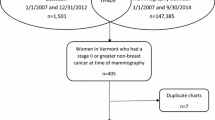Abstract
Background: Although clinical breast examinations (CBEs) provide important opportunities to detect breast cancer, little is known about factors that affect cancer detection during CBEs performed in community settings. To evaluate several potential factors, we analyzed data from 1,056,153 cancer screening records reported to the National Breast and Cervical Cancer Early Detection Program (NBCCEDP). Methods: Using case-series methods, we compared 2159 cancers missed during CBEs with 3161 cancers detected during CBEs. Cancers missed during CBE were found by mammography and confirmed by biopsy or fine needle aspiration. Results: After controling for cancer stage, tumor size, and breast symptoms at time of CBE, we found that patient age and CBE history were significantly associated with the likelihood of cancer detection. Compared to women 50–59, women 40–49 were more likely to have their cancer detected during CBE (odds ratio (OR) = 1.84, 95% confidence interval (95% CI) 1.47–2.29), while women 70 and older were less likely to have it detected (OR = 0.74, 95% CI: 0.55–1.00). Among women receiving their first NBCCEDP-funded CBE, 67.5% had their cancer detected by CBE. Among women receiving their second or third CBE, the values were 59.3 and 48.8%, respectively. In an adjusted logistic model, a significant inverse relationship was observed between number of prior CBEs and percent of cancers detected in the index CBE (OR = 0.79, 95% CI: 0.72–0.88). Conclusions: Among women diagnosed with breast cancer, older women and those who have had multiple CBEs were more likely to have their cancer missed during CBE.
Similar content being viewed by others
References
Barton MB, Harris R, Fletcher SW (1999) Does this patient have breast cancer? The screening clinical breast examination: should it be done? How? JAMA 282: 1270-1280.
Miller AB, To T, Baines CJ, Wall C (2000) Canadian national breast screening study-2: 13 year results of a randomized trial in women aged 50-59 years. JNCI 92: 1490-1499.
US Preventive Services Task Force (1996) Guide to Clinical Preventive Services. 2nd edn. Baltimore: Williams &; Wilkins.
Humphrey L, Helfand M, Chan B, Woolf SH (2002) Breast cancer screening: a summary of the evidence for the US Preventive Services Task Force. Ann Intern Med 137: 347-360.
Blackman DK, Bennet EM, Miller DS (1999) Trends in selfreported use of mammograms (1989-1997) and Papanicolaou tests (1991-1997)-Behavioral Risk Factor Surveillance System. MMWR 48: 1-22.
National Committee for Quality Assurance (1997) HEDIS 3.0/ 1998: Narrative-What's in it and Why it Matters. Vol. 1, Washington, D.C: National Committee for Quality Assurance, pp. 1-3.
Fletcher SW (2000) Following up abnormal breast cancer screening results: lessons for primary care clinicians. J Am Board Fam Pract 13: 152-154.
American College of Radiology (1995) Breast Imaging Reporting and Data System (BI-RADS). 2nd edn. Reston, VA: American College of Radiology.
Bobo JK, Lee NC, Thames SF (2000) Findings from 752,081 clinical breast examinations reported to a National Screening Programfrom995 through 1998. JNCI 92: 971-976.
Yang Q, Khoury MJ, Sun F, Flanders WD (1999) Case-only design to measure gene-gene interaction. Epidemiology 10: 167-170.
Begg CB, Zhang Z (1994) Statistical analysis of molecular epidemiology studies employing case-series. Cancer Epidemiol Biomarkers Prevention 3: 173-175.
Coates R, Uhler RJ, Brogan DJ, et al. (2001) Patterns and predictors of the beast cancer detection methods in women under 45 years of age (US). Cancer Causes Control 12: 431-442.
Farrington CP, Nash J, Miller E (1996) Case-series analysis of adverse reactions to vaccines: a comparative evaluation. AJE 143: 1165-1173.
McCarthy N, Gift Hc (1999) Case-case comparisons to study causation of common infectious diseases. Int J Biomed Comput 28: 764-768.
Henson RM, Wyatt SW, Lee NC (1996) The National Breast and Cervical Cancer Early Detection Program: a comprehensive public health response to two major health issues for women. J Public Health Manage Prac 2(2): 36-47.
May DS, Lee NC, Nadel MR, Henson RM, Miller DS (1998) The National Breast and Cervical Cancer Early Detection Program: report on the first 4 years of mammography provided to medically underserved women. Am J Roentol 170: 97-104.
American joint committee on cancer (1992) Manual for the Staging of Cancer. 4th edn. Philadelphia: Lippincott.
Surveillance, Epidemiology, and End Results Program (1986) Summary Staging Guide. Washington DC: US Department of Health and Human Services.
Fleiss JL (1981) Statistical Methods for Rates and Proportions. 2nd edn. New York: John Wiley &; Sons.
Breslow NE, Day NE (1992) Statistical Methods in Cancer Research. Vol. II. International Agency for Research on Cancer.
Maclure M, Greenland S (1992) Tests for trend and dose response: misinterpretation and alternatives. Am J Epidemiol 135: 96-104.
Eddy DM (1989) Screening for breast cancer. Ann Int Med 111: 389-399.
Oestreicher N, White E, Lehman C, Mandelson MT, Porter P, Taplin S (2002) Predictors of sensitivity of clinical breast examination (CBE). Breast Cancer Res Treat 76: 73-81.
Elmore JG, Barton MB, Moceri VM, Polk S, Arena PJ, Fletcher SW (1998) Ten-year risk of false positive screening mammograms and clinical breast examinations. NEJM 338: 1089-1096.
Leppert PC (1997) The importance of the gynecologic examination. In: Leppert PC, Howard FM, eds. Primary Care for Women, Philadelphia: Lippincott-Raven, pp. 25-29.
Pennypacker HS, Naylor L, Sander AA, Goldstein MS (1999) Why can't we do better breast examinations? Nurse Pract Forum 10: 122-128.
Henderson BE, Pike MC, Bernstein L, Ross RL (1996) Breast cancer. In: Schottenfeld D, Fraumeni Jr JF, eds. Cancer Epidemiology and Prevention, New York: Oxford, pp. 1022-1039.
Egglin TKP, Feinstein AR (1996) Context bias-A problemin diagnostic radiology. JAMA 276: 1752-1755.
Author information
Authors and Affiliations
Corresponding author
Rights and permissions
About this article
Cite this article
Bobo, J.K., Lawson, H.W. & Lee, N.C. Risk factors for failure to detect a cancer during clinical breast examinations (United States). Cancer Causes Control 14, 461–468 (2003). https://doi.org/10.1023/A:1024904104286
Issue Date:
DOI: https://doi.org/10.1023/A:1024904104286




